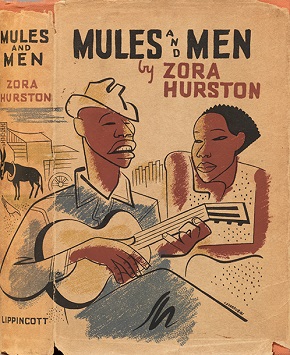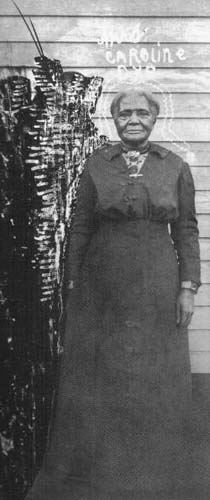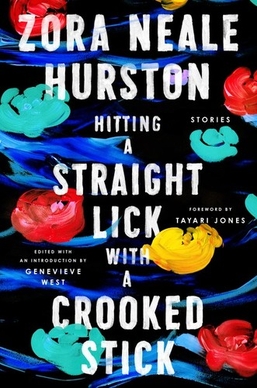A mojo, in the African-American spiritual practice called Hoodoo, is an amulet consisting of a flannel bag containing one or more magical items. It is a "prayer in a bag", or a spell that can be carried with or on the host's body. Alternative American names for the mojo bag include gris-gris bag, hand, mojo hand, toby, nation sack,conjure hand, lucky hand, conjure bag, juju bag, trick bag, tricken bag, root bag, and jomo. The word mojo also refers to magic and charms. Mojo containers are bags, gourds, bottles, shells, and other containers. The making of mojo bags in Hoodoo is a system of African-American occult magic. The creation of mojo bags is an esoteric system that involves sometimes housing spirits inside of bags for either protection, healing, or harm and to consult with spirits. Other times mojo bags are created to manifest results in a person's life such as good-luck, money or love.

Zora Neale Hurston was an American author, anthropologist, and documentary filmmaker. She portrayed racial struggles in the early-20th-century American South and published research on Hoodoo and Caribbean Vodou. The most popular of her four novels is Their Eyes Were Watching God, published in 1937. She also wrote more than 50 short stories, plays, and essays.

Alice Malsenior Tallulah-Kate Walker is an American novelist, short story writer, poet, and social activist. In 1982, she became the first African-American woman to win the Pulitzer Prize for Fiction, which she was awarded for her novel The Color Purple. Over the span of her career, Walker has published seventeen novels and short story collections, twelve non-fiction works, and collections of essays and poetry.

Hoodoo is a set of spiritual practices, traditions, and beliefs that were created by enslaved African Americans in the Southern United States from various traditional African spiritualities and elements of indigenous botanical knowledge. Practitioners of Hoodoo are called rootworkers, conjure doctors, conjure men or conjure women, and root doctors. Regional synonyms for Hoodoo include rootwork and conjure. As a syncretic spiritual system, it also incorporates beliefs from Islam brought over by enslaved West African Muslims, and Spiritualism. Scholars define Hoodoo as a folk religion. It is a syncretic religion between two or more cultural religions, in this case being African indigenous spirituality and Abrahamic religion.

Their Eyes Were Watching God is a 1937 novel by American writer Zora Neale Hurston. It is considered a classic of the Harlem Renaissance, and Hurston's best known work. The novel explores protagonist Janie Crawford's "ripening from a vibrant, but voiceless, teenage girl into a woman with her finger on the trigger of her own destiny".

John the Conqueror, also known as High John de Conqueror, John, Jack, and many other folk variants, is a folk hero from African-American folklore. He is associated with the roots of Ipomoea purga, the John the Conqueror root or John the Conqueroo, to which magical powers are ascribed in African-American folklore, especially among the Hoodoo tradition of folk magic. Muddy Waters mentions him as Johnny Cocheroo in the songs "Mannish Boy" and "I'm Your Hoochie Coochie Man". In "Mannish Boy", the line is "I think I'll go down/To old Kansas too/I'm gonna bring back my second cousin/That little Johnny Conqueroo". This line is borrowed from the Bo Diddley song "I'm a Man", to which "Mannish Boy" is an answer song. In "I'm Your Hoochie Coochie Man", it is called "John De Conquer Blue".

Their Eyes Were Watching God is a 2005 American television drama film based upon Zora Neale Hurston's 1937 novel of the same name. The film was directed by Darnell Martin, written by Suzan-Lori Parks, Misan Sagay, and Bobby Smith Jr., and produced by Oprah Winfrey's Harpo Productions. It stars Halle Berry, Ruben Santiago-Hudson, and Michael Ealy, and aired on ABC on March 6, 2005.

Larry Neal or Lawrence Neal was an American writer, poet, critic and academic. He was a notable scholar of African-American theater, well known for his contributions to the Black Arts Movement of the 1960s and 1970s. He was a major influence in both New York and Chicago, pushing for black culture to focus less on integration with White culture, rather than celebrating its differences within an equally important and meaningful artistic and political field, thus celebrating Black heritage.

Cudjoe Kazoola Lewis, born Oluale Kossola, and also known as Cudjo Lewis, was the third to last adult survivor of the Atlantic slave trade between Africa and the United States. Together with 115 other African captives, he was brought to the United States on board the ship Clotilda in 1860. The captives were landed in backwaters of the Mobile River near Mobile, Alabama, and hidden from authorities. The ship was scuttled to evade discovery, and remained undiscovered until May 2019.

Cane is a 1923 novel by noted Harlem Renaissance author Jean Toomer. The novel is structured as a series of vignettes revolving around the origins and experiences of African Americans in the United States. The vignettes alternate in structure between narrative prose, poetry, and play-like passages of dialogue. As a result, the novel has been classified as a composite novel or as a short story cycle. Though some characters and situations recur between vignettes, the vignettes are mostly freestanding, tied to the other vignettes thematically and contextually more than through specific plot details.

Africatown, also known as AfricaTown USA and Plateau, is a historic community located three miles (5 km) north of downtown Mobile, Alabama. It was formed by a group of 32 West Africans, who in 1860 were bought and transported against their will in the last known illegal shipment of slaves to the United States. The Atlantic slave trade had been banned since 1808, but 110 slaves held by the Kingdom of Dahomey were smuggled into Mobile on the Clotilda, which was burned and scuttled to try to conceal its illicit cargo. More than 30 of these people, believed to be ethnic Yoruba, Ewe, and Fon, founded and created their own community in what became Africatown. They retained their West African customs and language into the 1950s, while their children and some elders also learned English. Cudjo Kazoola Lewis, a founder of Africatown, lived until 1935 and was long thought to be the last survivor of the slaves from the Clotilda living in Africatown.
"The Gilded Six-Bits" is a 1933 short story by Zora Neale Hurston, who is considered one of the pre-eminent writers of 20th-century African-American literature and a leading prose writer of the Harlem Renaissance. Hurston was a relative newcomer on the literary scene when this short story was published, but eventually had greater success with her highly acclaimed novel, Their Eyes Were Watching God. "The Gilded Six-Bits" is now published in Hurston's compilation of short stories entitled Spunk in which it is now considered one of her best stories. "The Gilded Six-Bits" is a story full of love, betrayal, and forgiveness. It portrays the life of two happy newlyweds who both test their relationship and their love for one another when a charismatic outsider comes into their community and into their home. The story embodies Hurston's typical writing style in which it focuses on the common African-American lifestyle, represented by regional dialect and metaphors, and is set in her native town Eatonville, FL where it reflects the traditions of the community. "The Gilded Six-Bits" symbolizes the meaning of a true marriage and the truth that lies underneath its meaning.
Charlotte Osgood Mason, born Charlotte Louise Van der Veer Quick, was a white American socialite and philanthropist. She contributed more than $100,000 to a number of African-American artists and writers of the Harlem Renaissance, equal to more than $1 million in 2003. This was especially critical during the Great Depression, when foundation support declined. She helped young artists become established.

"Sweat" is a short story by the American writer Zora Neale Hurston, first published in 1926, in the first and only issue of the African-American literary magazine Fire!!. The story revolves around a washerwoman and her unemployed husband.

Mules and Men is a 1935 autoethnographical collection of African-American folklore collected and written by anthropologist Zora Neale Hurston. The book explores stories she collected in two trips: one in Eatonville and Polk County, Florida, and one in New Orleans. Hurston's decision to focus her research on Florida came from a desire to record the cross-section of black traditions in the state. In her introduction to Mules and Men, she wrote, "Florida is a place that draws people—white people from all over the world, and Negroes from every Southern state surely and some from the North and West". Hurston documented 70 folktales during the Florida trip, while the New Orleans trip yielded a number of stories about Marie Laveau, voodoo and Hoodoo traditions. Many of the folktales are told in vernacular; recording the dialect and diction of the Black communities Hurston studied.
Moses, Man of the Mountain is a 1939 novel by African-American novelist and anthropologist Zora Neale Hurston. The novel rewrites the story of the Book of Exodus of Moses and the Israelites from an Afro-American perspective. The novel applies a number of different motifs and themes commonly addressed in African-American culture, subverting the Moses story.

Seraph on the Suwanee is a 1948 novel by African-American novelist Zora Neale Hurston. It follows the life of a White woman and the fraught relationship she has with her husband and family.

Redoshi was a West African woman who was enslaved and smuggled to the U.S. state of Alabama as a girl in 1860. Until a later surviving claimant, Matilda McCrear, was announced in 2020, she was considered to have been the last surviving victim of the transatlantic slave trade. Taken captive in warfare at age 12 by the West African kingdom of Dahomey, she was sold to Americans and transported by ship to the United States in violation of U.S. law. She was sold again and enslaved on the upcountry plantation of the Washington M. Smith family in Dallas County, Alabama, where her owner renamed her Sally Smith.

Caroline Dye also known as Aunt Caroline, was a renowned African American Hoodoo woman, rental property investor, soothsayer, rootworker and conjuror based in Newport, Arkansas.

Hitting a Straight Lick with a Crooked Stick is a compilation of recovered short stories written by Zora Neale Hurston. It was published in 2020 by Amistad: An Imprint of HarperCollins publishers. ISBN 978-0-06-291579-5














